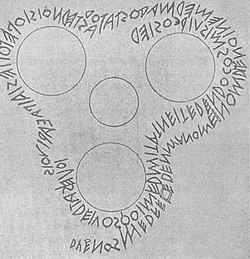Latin alphabet
| Latin | |
|---|---|
 | |
| Script type | |
Time period | c. 700 BC – present |
| Official script | show
131 sovereign states Co-official script in: show
12 sovereign states and 1 supranational organization |
| Languages |
|
| Related scripts | |
Parent systems | Egyptian hieroglyphs
|
Child systems | Numerous Latin alphabets; also more divergent derivations such as Osage |
Sister systems | |
| ISO 15924 | |
| ISO 15924 | Latn, , Latin |
| Unicode | |
Unicode alias | Latin |
Unicode range | See Latin characters in Unicode |
 |
| Calligraphy |
|---|
The Latin alphabet or Roman alphabet is the collection of letters originally used by the ancient Romans to write the Latin language and its extensions used to write modern languages.
Etymology
The term Latin alphabet may refer to either the alphabet used to write Latin (as described in this article) or other alphabets based on the Latin script, which is the basic set of letters common to the various alphabets descended from the classical Latin alphabet, such as the English alphabet. These Latin-script alphabets may discard letters, like the Rotokas alphabet, or add new letters, like the Danish and Norwegian alphabets. Letter shapes have evolved over the centuries, including the development in Medieval Latin of lower-case, forms which did not exist in the Classical period alphabet.
Evolution
The Latin alphabet evolved from the visually similar Etruscan alphabet, which evolved from the Cumaean Greek version of the Greek alphabet, which was itself descended from the Phoenician alphabet, which in turn derived from Egyptian hieroglyphics.[1] The Etruscans ruled early Rome; their alphabet evolved in Rome over successive centuries to produce the Latin alphabet. During the Middle Ages, the Latin alphabet was used (sometimes with modifications) for writing Romance languages, which are direct descendants of Latin, as well as Celtic, Germanic, Baltic and some Slavic languages. With the age of colonialism and Christian evangelism, the Latin script spread beyond Europe, coming into use for writing indigenous American, Australian, Austronesian, Austroasiatic and African languages. More recently, linguists have also tended to prefer the Latin script or the International Phonetic Alphabet (itself largely based on the Latin script) when transcribing or creating written standards for non-European languages, such as the African reference alphabet.
Signs and abbreviations
Although Latin did not use diacritical signs, signs of truncation of words, often placed above the truncated word or at the end of it, were very common. Furthermore, abbreviations or smaller overlapping letters were often used. This was due to the fact that if the text was engraved on the stone, the number of letters to be written was reduced, while if it was written on paper or parchment, it saved precious space. This habit continued even in the Middle Ages. Hundreds of symbols and abbreviations exist, varying from century to century.[2]
History
This section needs additional citations for verification. (July 2018) |
Origins
It is generally believed that the Latin alphabet used by the Romans was derived from the Old Italic alphabet used by the Etruscans.[citation needed] That alphabet was derived from the Euboean alphabet used by the Cumae, which in turn was derived from the Phoenician alphabet.[citation needed]
Old Italic alphabet

| Letters |
|---|